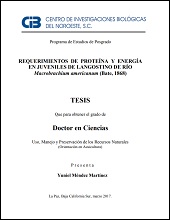| dc.contributor | EDILMAR CORTES JACINTO | |
| dc.creator | YUNIEL MENDEZ MARTINEZ | |
| dc.date | 2017-04 | |
| dc.identifier | http://cibnor.repositorioinstitucional.mx/jspui/handle/1001/464 | |
| dc.identifier.uri | http://dspace.cibnor.mx:8080/handle/123456789/2341 | |
| dc.description | "El langostino de río Macrobrachium americanum, ha despertado el interés, debido a sus características biológicas y a la necesidad de considerar especies alternativas para la acuicultura. Uno de los principales obstáculos que dificulta su tecnología de producción, es la falta de conocimiento y estudios en el cultivo larvario y juvenil en los aspectos nutricionales, pues aún no se conocen los requerimientos de proteína y energía. Así pues, la presente investigación busca generar conocimientos y resultados útiles sobre el uso de dietas formuladas para el langostino de río M. americanum. Se realizaron tres experimentos. Las larvas y juveniles de M. americanum empleados fueron obtenidos en condiciones de laboratorio a partir del desove de hembras silvestres. El Experimento I, consistió en evaluar el efecto del valor nutricional de nauplios de Artemia enriquecida con microalgas sobre el crecimiento y supervivencia en larvas de langostino. Se emplearon tres dietas diferentes, consistentes en nauplio de Artemia (D1), metanauplios I Artemia enriquecida con Tetraselmis suecica (D2) y metanauplios I Artemia enriquecida con Chaetoceros calcitrans (D3). Las larvas de langostinos alimentadas con la dieta D3 alcanzaron la mayor supervivencia, crecimiento y tasa de crecimiento, siendo la más efectiva de las tres dietas en estas condiciones experimentales. En el Experimento II, se determinó el efecto de cuatro concentraciones de proteína cruda 30.7, 37.2, 41.8 y 46.8% en dieta, sobre la respuesta productiva, composición proximal y aminoacídica corporal de juveniles de M. americanum. Langostinos alimentados con 37.2% de proteína cruda alcanzaron un peso final de 0.58 g (factor de conversión alimenticia de 2.15), que fue significativamente mejor. La supervivencia fue del 100% en todos los tratamientos. El contenido de proteína en las dietas tuvo efecto significativo en la composición proximal y el perfil de aminoácidos del cuerpo entero. Se ajustó la tasa de crecimiento a la línea discontinua de dos pendientes y estos resultados demostraron que la dieta a base de proteínas al 37.2% es óptima para juvenil de M. americanum. En el Experimento III, se evaluó el efecto de niveles de proteína (35 y 40%) y lípidos (6, 10 y 14 %) en dieta con arreglo factorial (3×2) para seis relaciones proteína/energía: 17, 18, 19, 20, 21 y 22 mg PC kj-¹ g-¹, sobre variables productivas, nutricionales, histológicas y bioquímicas de juveniles de langostino de río." | |
| dc.description | "The cauque river prawn, M. americanum has aroused the interest due biological characteristics and the need to consider alternative species for aquaculture. One of the main obstacles from the production technology of M. americanum is the deficiency of knowledge and studies in nutritional aspects in larval and juvenile. In M. americanum do not yet known the requirements of protein and energy. Thus, this research proposal seeks to generate knowledge and useful results on the use of diets formulated for the M. americanum. Three experiments were performed. The larvae and juveniles of M. americanum were obtained under laboratory conditions from the spawning of wild females. The Experiment I, consisted of evaluating the effect of the nutritional value of Artemia nauplii enriched with microalgae on the growth and survival of M. americanum larvae. Were used three different diets consisting in Artemia nauplii (D1), Artemia methanauplii I enriched with Tetraselmis suecica (D2) and Artemia methanauplii I enriched with Chaetoceros calcitrans (D3).The larvae of prawns fed with the diet D3 reached the highest survival, growth and growth rate significantly, being the most effective of the three diets in the experimental conditions of this study. In the Experiment II, we determined the effect of four concentrations of dietary crude protein, 30.7, 37.2, 41.8 and 46.8% on growth rate, survival and body composition of the M. americanum juvenile. The effect of four concentrations of crude protein 30.7, 37.2, 41.8 and 46.8% on diet, on the productive response, proximal composition and body aminoacid composition of juveniles of M. americanum were determined. Survival was 100% in all treatments. Prawns consuming 37.2% crude protein reached a final weight of 0.58 g (feed conversion ratio of 2.15) which was significantly better. Protein content in the diets had a significant effect on whole body proximate composition and amino acid profile. Specific growth rate was adjusted to the two-slope broken-line to estimate the optimal protein requirement. These results demonstrated that the 37.2% protein level diet is optimal for juvenile cauque." | |
| dc.format | application/pdf | |
| dc.language | spa | |
| dc.publisher | Centro de Investigaciones Biológicas del Noroeste, S.C. | |
| dc.rights | info:eu-repo/semantics/openAccess | |
| dc.rights | http://creativecommons.org/licenses/by-nc-nd/4.0 | |
| dc.subject | info:eu-repo/classification/AUTOR/Dietas, crecimiento, composición química, sistema digestivo, langostino de río | |
| dc.subject | info:eu-repo/classification/AUTOR/Diets, growth, chemical composition, digestive system, river prawn | |
| dc.subject | info:eu-repo/classification/cti/6 | |
| dc.subject | info:eu-repo/classification/cti/31 | |
| dc.subject | info:eu-repo/classification/cti/3104 | |
| dc.subject | info:eu-repo/classification/cti/310406 | |
| dc.subject | info:eu-repo/classification/cti/310406 | |
| dc.title | Requerimientos de proteína y energía en juveniles de langostino de río Macrobrachium americanum (Bate, 1868) | |
| dc.type | info:eu-repo/semantics/doctoralThesis | |
| dc.type | info:eu-repo/semantics/publishedVersion | |


